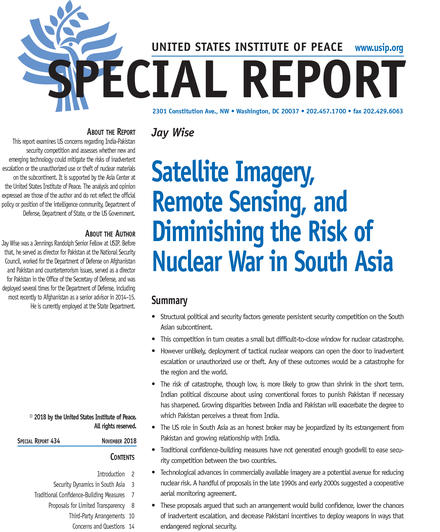 The backdrop: a security rivalry between India and Pakistan in place since the 1947 partition of British India. The risk: nuclear catastrophe. Because the consequences of such an outcome are so dire, even the small chance of a nuclear conflict is worth trying to minimize. This report assesses whether satellite imagery and remote sensing technology, administered by a trusted third party, could ease the pressures and thus lessen the risk of disaster on the subcontinent.
The backdrop: a security rivalry between India and Pakistan in place since the 1947 partition of British India. The risk: nuclear catastrophe. Because the consequences of such an outcome are so dire, even the small chance of a nuclear conflict is worth trying to minimize. This report assesses whether satellite imagery and remote sensing technology, administered by a trusted third party, could ease the pressures and thus lessen the risk of disaster on the subcontinent.
Summary
Structural political and security factors generate persistent security competition on the South Asian subcontinent.
This competition in turn creates a small but difficult-to-close window for nuclear catastrophe.
However unlikely, deployment of tactical nuclear weapons can open the door to inadvertent escalation or unauthorized use or theft. Any of these outcomes would be a catastrophe for the region and the world.
The risk of catastrophe, though low, is more likely to grow than shrink in the short term. Indian political discourse about using conventional forces to punish Pakistan if necessary has sharpened. Growing disparities between India and Pakistan will exacerbate the degree to which Pakistan perceives a threat from India.
The US role in South Asia as an honest broker may be jeopardized by its estrangement from Pakistan and growing relationship with India.
Traditional confidence-building measures have not generated enough goodwill to ease security competition between the two countries.
Technological advances in commercially available imagery are a potential avenue for reducing nuclear risk. A handful of proposals in the late 1990s and early 2000s suggested a cooperative aerial monitoring agreement.
These proposals argued that such an arrangement would build confidence, lower the chances of inadvertent escalation, and decrease Pakistani incentives to deploy weapons in ways that endangered regional security.
No comments:
Post a Comment